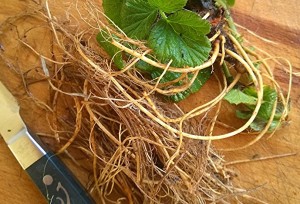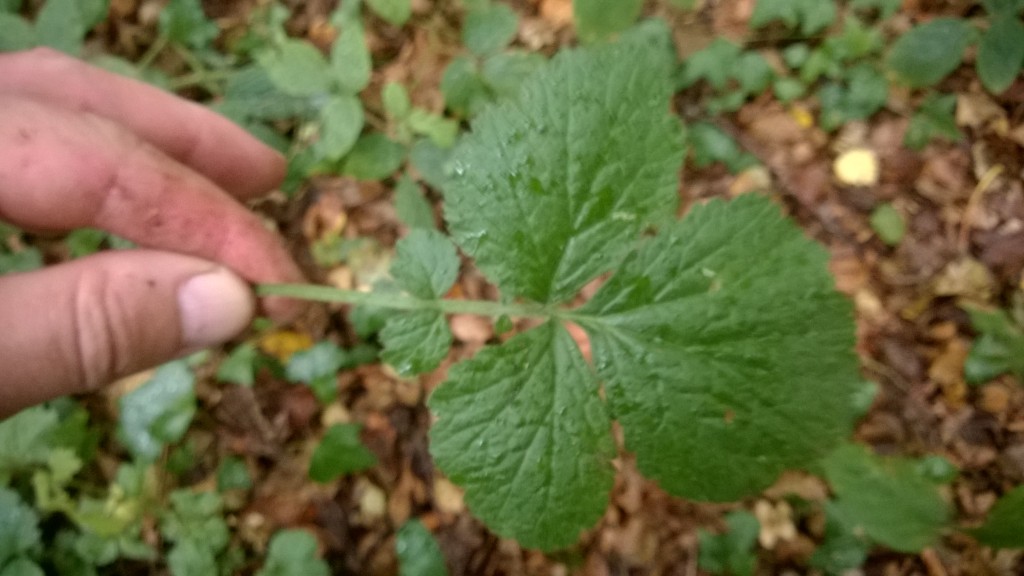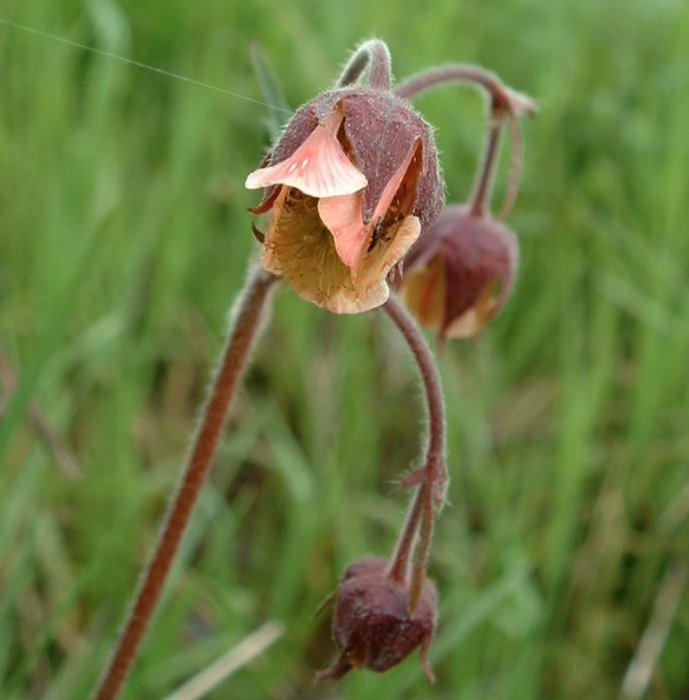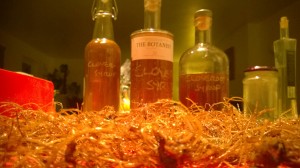Wood Avens – Edibility, Identification, Distribution
Geum urbanum AKA Herb bennet or Cloveroot
- Identification 3/5 – Fairly distinctive rosettes of trifoliate rounded, lobed leaves with smaller paired leaves further down the stem. When the flower stems grow (up to 70cm), higher leaves are more pointed and angular, though with the same format. Yellow flowers have 5 petals and 5 sepals and often look small in relation to the plant. When flowers aren’t present, it is easy to mix up with closely related water avens (geum rivale). This is not a dangerous mistake, but water avens root are even finer and lack the clove flavour (though some say they have a chocolaty flavour, I have never managed to taste it).
- Edibility – Leaves 2/5, Roots 4/5 – The flavour is in the small, fine, string-like roots, no more than 2mm diameter
- Habitat – Woods and hedgerows, especially path edges
- Distribution – 5 – Very common throughout the UK
- Season – all year. Roots are best harvested December – April
This is a super-common plant of wood edges (and often deeper in the forest where light penetrates) and hedgerows, with a long history of medicinal use and as a pre-hops medieval brewing ingredient, as described in this interesting recipe from a letter of 1430:
“Pur faire holsom drynk of ale, Recipe sauge [sage], auence [wood avens], rose maryn, tyme, chopped right smal, and put this and a newe leyd hennes ey [egg] in a bage and hange it in the barell… the ey [egg] of the henne shal kepe the ale fro sour.” – The Paston Letters.
Hmmm…think i’ll keep my newe leyd hennes eys for breakfast…but there are certainly plenty of drinks uses for wood avens. As well as in beers, the roots work as a mulling spice in wine, cider, whisky or (hot buttered) rum; as a sweet note in bittersweet preparations such as vermouth or amaro; and its also great with apples, plums and other stone fruit – I use the syrup to sweeten my sloe gin. They also makes a great liqueur in their own right – see below.
The leaves can be used as a pot-herb in spring and summer but their flavour is unremarkable. The part that commands my attention is the root, which has a distinct flavour of cloves. It is just one of many native spices which we have chosen to neglect in favour of imports – read more about our native wild spice rack here. It can be used as a spice in the same way as you may use cloves – as a warm “mulling” flavour (try infusing into sloe gin or eldeberry ice cream), or in spicy dishes and masalas that call for cloves (finely chop the cleaned roots and blend in with the other spices). While wood avens roots aren’t quite as pungent as whole cloves, they are more than just a “taste-alike”, sharing the same chemical component (eugenol) that gives cloves their aromatic pungency.

Wood avens roots. It is these fine roots that contain the flavour, not the larger solid bit of root they grow from, though it does no harm to add all of them when making syrup.
Uprooting plants is technically illegal without the landowners permission. Nobody is likely to object to you harvesting domestic quantities of this “weed”, but don’t clear out whole areas of it. The roots are shallow and fine, so I often uproot, remove about 1/3rd, then replant. This takes very little time and you can feel good in the knowledge that the plant can continue its business with minimal inconvenience. Once you get the muddy root balls home, the real hard work of cleaning them starts… I put them in a basket and blast them with a hose outdoors, before rinsing again in the sink, then scrubbing each root ball with a nail brush, and rinsing some more. Its a bit of a faff, but worth the trouble.
I make a rich, clove scented syrup by very gently simmering generous amounts of the cleaned roots in 2:1 sugar:water solution for 15 minutes then leaving to infuse for a few weeks. The resulting syrup will keep well if you add a wee glug of neutral spirit. I then use it to sweeten cocktails, aromatised wines, desserts etc – its great on, or as a “ripple” in ice creams. Its also my absolute go-to sweetener for ground ivy vinegar – the finest pickling solution in the known universe!
Once removed, the now “candied” roots can be dehydrated and finely ground (you’ll need a good coffee grinder and/or a hefty pestle) to make a sweet clove powder for sprinkling on desserts or on the rim of cocktail glasses.
Or if you prefer, leave the syrup-soaked roots in a kilner and pour over a cheap(ish) bottle of vodka. Leave it for a couple of months to extract the last vestiges of flavour and you will end up, once strained and perhaps after a tweak to the sweetness, with a fine liqueur, like boozy oddfellows – a traditional Scottish candy imparted with clove/cinnamon flavour.




12 Comments
Hi Mark, love the idea of putting the ground candied root on cocktail glasses, plan to pinch that idea! Once you’ve added some spirit to the syrup, do you keep the syrup in the fridge or not? I don’t add spirit to my syrups but then find I need to keep them in the fridge to keep them for any more than a few weeks, or freeze to keep for longer.
Hi Sarah,
You have to grind the candied root quite fine, then sieve I find.
I don’t keep my syrups in the fridge and they last fine. I make a strong syrup 2 sugar: 1 water, plus some alcohol, really works well.
Happy foraging,
Mark.
I was planning to have a go at making this syrup as I want to try your recipe for tonic water 🙂 Approximately how much root do I need?
Hi Helen,
I use enough to loosely fill the jar I am using. I’m afraid that is as precise as I get! Once you have drained off the syrup, refill the root-filled jar with vodka and leave for a month or so. Makes the most amazing cloveroot liquer. For now extra work! Highly, highly recommended!
This (or indeed any) syrup isn’t essential for dandelion tonic.
Cheers
Mark.
Hi!
Can this be used the same way as say, water avens Geum rivale, who’s roots are said to taste like hot chocolate when cooked with milk and sugar? Does it make a descent fresh drink, or does it need to be turned into alcohol?
Hi Liz, My experience of water avens is that the flavour in the roots isn’t so pronounced – at least certainly not the clove flavour. I’m intrigued by the hot chocolate possibilities – i’ll be checking that out! Wood avens roots can be chewed, chopped or infused into anything you like – it doesn’t need to be alcohol. That’s just my Scottishness coming out… 😉
Mark.
The rear of my garden is smothered in Wood avens. I am going to put my veg plot there, but it is great to know I have a useful weed. Will be leaving some to grow on, beside the nettle patch and I look forward to using it.
I live in quite a wild hedgerowed area and this appeared in my garden this year. I hate destroying useful plants, even if gardeners would usually dismiss as weeds.
I look forward to trying the roots in my mulled wine this Christmas. Can they be dried for keeping as a powder?
They can be dried, though they do lose some of their pungency.
This sounds amazing, I love cloves but want to avoid imported produce where possible.
This grows all over my shady garden and spreads into my cultivated bit. Now I know it has a real use I will feel happier about digging it up. I look forward to making the syrup.
We’ve just been using the cloveroot syrup I’ve made recently, it’s lovely. Thank you for this recipe Mark.